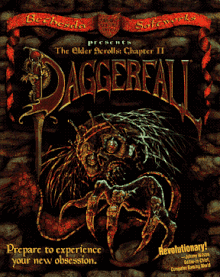
Back ذا إيلدر سكرولز 2: داغر فال Arabic ذا ايلدر سكرولز 2: داجر فال ARZ The Elder Scrolls II: Daggerfall Czech The Elder Scrolls II: Daggerfall German The Elder Scrolls II: Daggerfall Spanish الدر اسکورولز ۲: دگرفال Persian The Elder Scrolls II: Daggerfall Finnish The Elder Scrolls II: Daggerfall French The Elder Scrolls II: Daggerfall Hungarian The Elder Scrolls II: Daggerfall Italian
| The Elder Scrolls II: Daggerfall | |
|---|---|
 North American box art by Louise Sandoval | |
| Developer(s) | Bethesda Softworks MediaTech West[1] |
| Publisher(s) | Bethesda Softworks |
| Director(s) | Julian Lefay |
| Designer(s) | Julian Lefay Bruce Nesmith Ted Peterson |
| Programmer(s) | Hal Bouma Julian Lefay |
| Artist(s) | Mark K. Jones Hoang Nguyen Louise Sandoval |
| Composer(s) | Eric Heberling |
| Series | The Elder Scrolls |
| Engine | XnGine |
| Platform(s) | MS-DOS |
| Release | |
| Genre(s) | Action role-playing |
| Mode(s) | Single-player |
The Elder Scrolls II: Daggerfall is an open-world, action role-playing game published by Bethesda Softworks. The second video game in the Elder Scrolls series, it was released on September 20, 1996 for MS-DOS, following the success of 1994's The Elder Scrolls: Arena. The story follows the player, sent by the Emperor, to free the ghost of King Lysandus from his earthly shackles and discover what happened to a letter sent from the Emperor to the former queen of Daggerfall.
Compared to its predecessor, Arena, the player can now only travel within two provinces in Tamriel: High Rock and Hammerfell; however, Daggerfall consists of 15,000 cities, towns, villages, and dungeons for the character to explore. Arena's experience-point based system was replaced with a system that rewards the player for utilizing role-playing elements within the game.[2] Daggerfall includes more customization options, featuring an improved character generation engine, as well as a GURPS-influenced class creation system, offering players the chance to create their own classes and assign their own skills.[3][4]
The game was a critical and commercial success, with sales around 700,000 copies by 2000. The game was followed by The Elder Scrolls III: Morrowind in 2002. In 2009, to commemorate the fifteenth anniversary of the Elder Scrolls franchise, Daggerfall was made free to download from the Bethesda website.[5]
- ^ Andriesen, David (March 15, 1998). "Gaming guru finds home for company in Olympia". The Olympian. p. 68. Archived from the original on July 31, 2022. Retrieved August 2, 2022 – via Newspapers.com.
- ^ Cite error: The named reference
DFBTSwas invoked but never defined (see the help page). - ^ Cite error: The named reference
NGM 1995was invoked but never defined (see the help page). - ^ Cite error: The named reference
TEDDERSwas invoked but never defined (see the help page). - ^ Thompson, Michael (July 10, 2009). "Bethesda releasing Daggerfall for free". Arstechnica.com. Retrieved December 2, 2011.